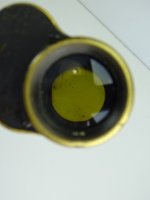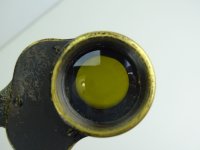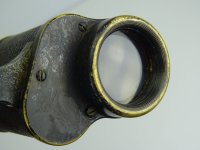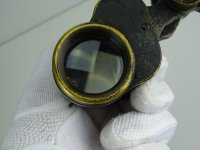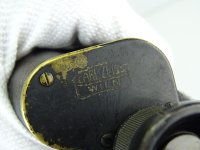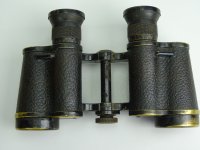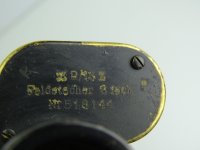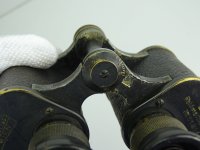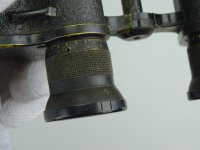-
Welcome to BirdForum, the internet's largest birding community with thousands of members from all over the world. The forums are dedicated to wild birds, birding, binoculars and equipment and all that goes with it.
Please register for an account to take part in the discussions in the forum, post your pictures in the gallery and more.
You are using an out of date browser. It may not display this or other websites correctly.
You should upgrade or use an alternative browser.
You should upgrade or use an alternative browser.
Opaque and greenish view (3 Viewers)
- Thread starter Ignatius
- Start date
More options
Who Replied?Ignatius
Pigasus J. Pig IX for President

Could than not be a 'bubble' where the achromat is separating?
BTW: it is a 1915 Carl Zeiss Wien Feldstecher 6fach M 9/13 Z with a dated Übernahmekommission engraving from 2.11.15. These are the same as Silvamars. In Seeger's blue book it is discussed on pp. 478-481. Serial 519144.
BTW: it is a 1915 Carl Zeiss Wien Feldstecher 6fach M 9/13 Z with a dated Übernahmekommission engraving from 2.11.15. These are the same as Silvamars. In Seeger's blue book it is discussed on pp. 478-481. Serial 519144.
Last edited:
pat mitchel
Well-known member
I'd also use some light coming through the eyepiece while moving it around the EP and taking the same look through the objective. A small light source that can be placed to the objective and moved about may also aid in the diagnosis. Always better for the doctor to know pertinent info on the patient. Good luck! Pat
pat mitchel
Well-known member
Nyogel 767A in the US. As to local availability, I don't know.
pat mitchel
Well-known member
I don't have any specs or even the knowledge as to what a "damping grease" is in comparison to other forms of grease. But a helical thread has a large contact area and that would seem to me to work against a thick grease. This might provide ample range of thickness


Helical Grease #500 15ml Made in Japan | eBay
Use best Helical Grease for your lens! Helical Grease are manufactured in Japan. 100% Made in Japan Degree of viscosity : #500.
www.ebay.com
Ignatius
Pigasus J. Pig IX for President

@pat mitchel : Someone else recommended that helical grease, but #3000 with a viscosity index of 270.
@Foss : Nyogel 774H with a viscosity index of 289 was suggested by someone.
Both those tips came from another bino forum. #500 grease has a viscosity index of 260. Seems like the answer will lie somewhere in that range then, 260 - 289. Apparently that range has a JIS & NLGI number of 2, which according to a wikipedia entry on the topic makes it as gooey as peanut butter ...
Silicone-based or lithium grease?
@Foss : Nyogel 774H with a viscosity index of 289 was suggested by someone.
Both those tips came from another bino forum. #500 grease has a viscosity index of 260. Seems like the answer will lie somewhere in that range then, 260 - 289. Apparently that range has a JIS & NLGI number of 2, which according to a wikipedia entry on the topic makes it as gooey as peanut butter ...
Silicone-based or lithium grease?
Last edited:
pat mitchel
Well-known member
this off the net
"It's not advisable to use them on plastic parts. As lithium is based on petroleum, it tends to speed up the decay of rubber and plastic components. Lithium-based grease can withstand high temperatures and are perfect for cars, heavy machinery, and guns."

 www.quora.com
www.quora.com
Pat
"It's not advisable to use them on plastic parts. As lithium is based on petroleum, it tends to speed up the decay of rubber and plastic components. Lithium-based grease can withstand high temperatures and are perfect for cars, heavy machinery, and guns."

What are the differences between white grease, lithium grease and synthetic grease?
Answer (1 of 2): There are many different greases and they all suit different purposes. The white greases I have seen used are on anything remotely to do with food production. Normal oils and greases are poisonous to animal life. Lithium greases are normal everyday, nothing special greases. Mo...
Pat
Ignatius
Pigasus J. Pig IX for President

Look carefully at the pictures of the eyepieces. Note that there are filter cups installed on each eyecup. This will account for a great deal of the lens colouration. Also, the photographs have an excessively green colour balance distorting the actual appearance of the binocular. So I’d say those are yellow or orange filters.
Last edited:
Ignatius
Pigasus J. Pig IX for President

Yup. I can see where he's coming from. I hope he's right, because that could possibly mean a lot less of a hassle. I am just reading up about the use of filters for binos back then in the blue book.
The Ü.K. stamp is from a military agency responsible for purchases for the artillery as I understand it. According to the blue book the stamp dates release of the binos to the troops, but it does not necessarily correspond to the serial number. Often the Ü.K. date is between 3 months and a year after the production date. The symbol is the double-headed eagle of the Austro-Hungarian empire. It was used for that purpose until sometime in 1916 from when the 'Allianzwappen' was used. That thing in itself is a complicated symbol to understand consisting of three coats of arms: the Austrian one and the Hungarian one connected in the middle by a small Habsburg one.
I am in the process of finding out whether the current agency has anything to do with that. Apparently an agency of this name was already in existence in the Napoleonic wars. The Swiss seem to have something of that name, too.
Cannot wait to hold it in my sweaty little paws.
The Ü.K. stamp is from a military agency responsible for purchases for the artillery as I understand it. According to the blue book the stamp dates release of the binos to the troops, but it does not necessarily correspond to the serial number. Often the Ü.K. date is between 3 months and a year after the production date. The symbol is the double-headed eagle of the Austro-Hungarian empire. It was used for that purpose until sometime in 1916 from when the 'Allianzwappen' was used. That thing in itself is a complicated symbol to understand consisting of three coats of arms: the Austrian one and the Hungarian one connected in the middle by a small Habsburg one.
I am in the process of finding out whether the current agency has anything to do with that. Apparently an agency of this name was already in existence in the Napoleonic wars. The Swiss seem to have something of that name, too.
Cannot wait to hold it in my sweaty little paws.
Users who are viewing this thread
Total: 4 (members: 0, guests: 4)





